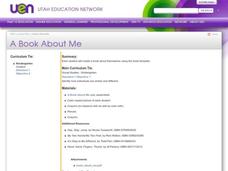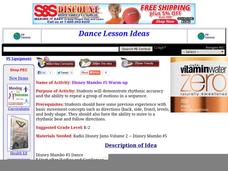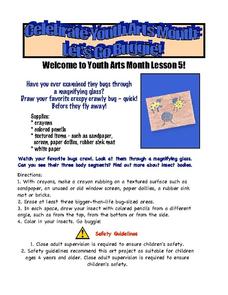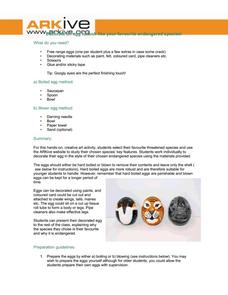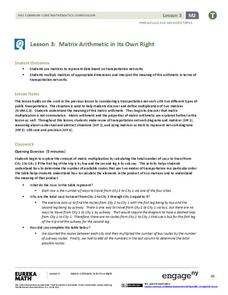Curated OER
Sand Crabs
Students identify shapes to create sand crabs, and make colored sand for texture.
Curated OER
A Book About Me
How big is your foot? How long is your arm? How big is your mom’s hand? After learning how to measure body parts, young writers collect their observations into an illustrated book. Instructions for crafting a 3D Tim Foil Man are also...
Curated OER
Snakes: Recycled Art
Make snakes with your class to demonstrate how recycled materials are perfect for art. Learners use colorful plastic cups, pantyhose, paper fasteners, and fishing line to make articulated snakes. This project would be great when learning...
Curated OER
Number Search in Monterey Bay Aquarium
Youngsters search for an animal with body parts for each number from one to ten during a field trip to an aquarium. They count rays, fins, feet, gills, eyes, spots or anything. When they get back to the classroom, they compile their...
Curated OER
Gravity Versus The Mighty Egg - Biology Teaching Thesis
Students are able to describe the principles of gravity. They name other places in the real world where we compensate for gravity. Students design a shock absorber with limited materials and explain how it works to protect an egg. They...
Curated OER
Pythagorean Theorem
In this pythagorean theorem worksheet, students identify the missing length of one side for 10 triangles. Each triangle gives the lengths of two sides and students must find the length of the third.
Curated OER
Exploring and Using Shapes to Make a Dance
Second graders use their bodies to create various shapes to make a dance when given various music and beats. In this shapes and dance lesson plan, 2nd graders create lines, curves, twists, and angles with their bodies.
Curated OER
Hitchhikers in the Bathroom
Young scientists will go buggy over this resource. After reading a passage that describes the pseudoscorpion, individuals respond to questions about this clever arachnid and use a Venn diagram to compare the pseudoscorpion to a real...
Curated OER
Fitness Dance
Get those youngsters moving! The activities put together to music are every day warm-up exercises. Jogging in place, jumping jacks, arm circles, and toe touches are a few of the movements presented to get children moving. Teach them the...
Curated OER
Disney Mambo #5 Warm-up
When the music starts to play, everyone wants to get up and move to this song. Teach your class some basic steps and body moves to the beat of this mambo song. Each of the movements is repeated, which means that youngsters are not having...
Arts & Humanities
Let's Go Buggie!
To celebrate art youth month, little ones get out the magnifying glasses and get close-up with bugs. They make scientific observations of bugs you bring into the classroom. Then, they use markers, clay, paint, or crayons to make artistic...
ARKive
Endangered Animal Easter Eggs
I love any lesson that addresses more than one subject area. You and your class will discuss endangered animals; each child will choose one animal and then create a decorated egg to represent their animal. After the eggs are decorated,...
Terminix
Amazing Insect Facts
Insects are like little aliens living all around us. Explore fun and interesting insect facts by having the class read a short informational paragraph. The paragraph focuses on how we are similar and different to insects and includes...
PEGAMES.org
Alphabet Aerobics
Whether using the alphabet, songs, poems, or rhymes, give your learners an opportunity to get their minds and bodies moving with this fun activity. This can be adapted to a range of movements or topics that you might like to incorporate,...
Education Outside
Creature Jeopardy!
After conducting research on a given scientific animal name, group members take a walk around their school and look for the specified animals in that classification. Then, they come back to their worksheets and create five creative clues...
Roland Park Country School
Butterfly or Moth?
What is the main difference between a moth and a butterfly? Butterflies have club-shaped antennae, while moths have a feather-like antennae. But what else differentiates these beautiful insects? The presentation in the resource...
School Specialty
The Tortoise and the Hare - Drawing Conclusions/Predictions Outcomes
Does the fastest one always win the race? Look deeper into The Tortoise and the Hare with a set of discussion questions for before, during, and after reading the story.
Charleston School District
Pythagorean Theorem and Converse
You've heard that it is true, but can you prove it? Scholars learn the Pythagorean Theorem through proof. After an overview of proofs of the theorem, learners apply it to prove triangles are right and to problem solve. This is the second...
EngageNY
Matrix Arithmetic in Its Own Right
Matrix multiplication can seem random to pupils. Here's a instructional activity that uses a real-life example situation to reinforce the purpose of matrix multiplication. Learners discover how to multiply matrices and relate the process...
EngageNY
Informal Proof of the Pythagorean Theorem
Prove the Pythagorean Theorem using multiple informal proofs. Scholars first develop an understanding of the origins of the Pythagorean Theorem through proofs. They round out the lesson by using the theorem to find missing side lengths...
Read Works
Halloween Leftovers
Halloween isn't fun for everyone — but playing together is! Read about Esme and her space pirate friend with a short reading passage, accompanied by ten short answer questions.
American Museum of Natural History
Extreme Mammals
Extreme characteristics can create some unusual mammals. Learners flip through a slide show of some of the most interesting mammals that are both living and extinct. Implement as a remote learning resource or use in-class to review...
American Museum of Natural History
All About Horses
Horses come in all shapes and sizes, but all belong to the same species. Young scholars explore the different traits and connect the information to genetic modification. The interactive gives them the option to read about 18 different...
American Museum of Natural History
Mammal Flipbooks
Scholars follow eight steps to create a flipbook and discover key facts about mammals' locomotion.
Other popular searches
- Bird Legs
- Counting Coins Using Legs
- Animal Legs
- Arachnids and Insects Legs
- Joanna Cole Bony Legs
- Coin Counting Legs
- Bony Legs by Joanna Cole
- Money Counting Legs
- Shoes Legs
- Coin Counting With Legs
- Bony Legs
- Insects Legs

